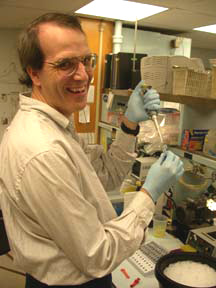
James M. Nolan, Ph.D.
and RNA-Protein Interactions

James M. Nolan, Ph.D. Duke University, 1988
Research Assistant
Professor of Biochemistry
Ribozyme Structure and Function
and RNA-Protein Interactions |
|
Research Interests Dr. Jim Nolan is a molecular biologist studying ribozyme structure-function and
RNA-protein interactions. He also is using bioinformatic approaches to study viral
genome evolution and bioprocess development. Research Description We are examining structural aspects of RNA-protein interactions using the bacterial
ribonuclease P (RNase P) holoenzyme as a model system. RNase P consists of a large RNA
and a small protein subunit, which together cleave 5'-precursor sequences from tRNA transcripts.
In vitro at high ionic strength, the RNA subunit is the catalytic moiety and the protein is
dispensable for catalysis. Although the RNase P protein is not required for activity in vitro,
it is essential for viability in vivo. In addition, the kinetics of the holoenzyme reaction in
vitro differs dramatically from the RNA-alone reaction in salt requirement, substrate
specificity, and reaction rate. We are using a detailed structural analysis of the RNase P RNA-protein complex to investigate
the how the protein binds to RNase P RNA, and how this binding affects the reaction mechanism,
including changes in how the RNase P RNA interacts with its tRNA substrate in the presence of
RNase P protein. These problems are being studied by a variety of techniques. We have
incorporated crosslinking reagents at specific sites of both the RNA and protein subunits
to further characterize the sites of interaction between the two subunits. Regions of the
RNase P protein important for interaction with RNase P RNA were identified by in vitro and
in vivo analyses of mutations in the RNase P protein. RNase P protein has an unusual protein-folding motif, a left-handed crossover connection
as part of central sheet RNA binding cleft. This unusual structure is shared with ribosomal
protein S5 and elongation factor EF-G. Together, the proteins represent a novel class of RNA
binding protein although they lack significant sequence homology between the group members.
This structural conservation among widely divergent sequences will be exploited to investigate
important determinants of RNase P protein function as well as determinants responsible
for folding of the protein domain. In collaboration with Jim D. Karam, we are performing a genomic
sequence analysis of T4-like bacteriophages to survey global evolution
of viral genomes. The genome sequences will provide phylogenetic variant
sequences of known proteins and will validate predicted small open reading
frames (ORFs). Results will be disseminated via the Phage Genome Browser
(phage.bioc.tulane.edu), which
highlights genome features and provides links to gene-specific information. In collaboration with Joan Bennett, we are investigating fungal genomics for biomass conversion.
We seek to identify new protein sequences from databases using bioinformatics tools to expand
capabilities for fungal bioprocess development. We are also engaged in collaborative efforts with Joseph Lasky to use ribozymes to inactivate
cytokine mRNAs in mouse. |